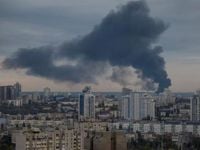On the night of September 28, 2025, the skies over Eastern Europe were anything but quiet. As Russian forces unleashed a massive barrage of missiles and drones against Ukraine, the reverberations were felt far beyond the immediate warzone. In a swift and dramatic response, Poland closed its eastern airspace near the cities of Lublin and Rzeszów, a move that underscored just how close the conflict has come to NATO’s doorstep and how rapidly European security dynamics are shifting.
The events began to unfold as Ukraine faced one of the most intense aerial assaults since the start of the war. According to defencematters.eu, Russian forces launched nearly 600 one-way attack drones and close to 50 missiles over roughly 12 hours, targeting Kyiv and several other regions including Zaporizhzhia, Sumy, Odesa, and Khmelnytskyi. The onslaught left at least four people dead—including a 12-year-old girl in Kyiv—and dozens injured. Residential buildings and the capital’s Institute of Cardiology were among the structures hit, with rescue workers later finding the bodies of two victims at the hospital.
The Ukrainian Air Force reported intercepting an astonishing 611 aerial threats, a testament to both the scale of the attack and the growing proficiency of Ukraine’s air defenses. Yet, as the missiles and drones rained down, the sheer volume proved difficult to fully contain. In Odesa, a wine factory was destroyed, while in the Sumy region, Russian strike drones injured two civilians in Konotop. The devastation extended to vital infrastructure and civilian areas alike, ensuring that the political and humanitarian costs would be felt for days to come.
For Poland, the proximity of the attacks was impossible to ignore. As the barrage unfolded, Polish authorities scrambled fighter jets and promptly declared a high state of military alert. Only NATO military flights—such as refueling planes and surveillance aircraft—were permitted to remain in the airspace, which was closed to all civilian traffic until at least 4:00 a.m. GMT on September 29, 2025. An Australian E-7 Wedgetail, a sophisticated long-range radar and control aircraft, was seen patrolling the Polish-Ukrainian border, providing critical intelligence and support to Ukrainian air defenses. Reuters and Flightradar24 data confirmed that the closure was officially attributed to “unplanned military activity related to ensuring national security.”
The significance of Poland’s decision was not lost on its neighbors. Denmark and Estonia both raised their security alert levels in the wake of increased aerial threats, and Denmark went so far as to ban civilian drone flights ahead of a major EU summit, citing a “difficult security situation.” As Danish Defence Minister Troels Lund Poulsen stated, “We must ensure the best possible working conditions for the armed forces and police.” Additional military assets were deployed, and several airports were temporarily closed to prevent confusion between friendly and hostile drones.
NATO, meanwhile, responded with characteristic resolve. The alliance boosted its regional defenses, deploying an air defense frigate and enhanced surveillance platforms in the Baltic Sea region. A German air defense frigate’s arrival in Copenhagen signaled NATO’s readiness to protect regional airspace during high-profile events. According to defencematters.eu, NATO officials openly warned Russia that any further airspace violations could prompt a decisive response, and British, French, and German ambassadors confronted Russian officials in Moscow over deliberate incursions. The Kremlin, for its part, denied any wrongdoing and accused the West of “scaremongering,” but the repeated incidents left little doubt about the seriousness of the threat.
The timing of the Russian assault was also notable. It followed a week of United Nations diplomacy in New York, where U.S. President Donald Trump signaled a rhetorical shift by stating Ukraine “can retake all its land” and highlighting Russian economic vulnerabilities. Kyiv welcomed the remarks, but as defencematters.eu noted, there was no clear indication of substantive policy changes to match the new language. Russian Foreign Minister Sergei Lavrov, in his own UN address, framed NATO and European states as escalatory actors and warned of a “decisive response” if Russia were “provoked,” while also claiming no intent to attack Europe. This dual message—deterrent threats coupled with denials of wider intent—tracks with a long-running Russian narrative aimed at shaping European risk perceptions.
Amid the diplomatic maneuvering, U.S. Secretary of State Marco Rubio met with Lavrov on the margins of the UN General Assembly. Both sides described the exchange as “constructive,” even as positions on Ukraine remained far apart. The State Department emphasized that Washington reiterated the need for Russia to stop the killing and take verifiable steps toward a durable end to the war, while Moscow portrayed the meeting as consistent with a previously agreed leadership “line.”
Analysts have been quick to point out that the scale and composition of the September 28 strike—hundreds of low-cost drones alongside cruise and ballistic missiles—was designed to saturate Ukrainian defenses and exploit stockpile constraints, particularly for interceptor missiles. While Moscow claimed military objectives, the confirmed damage to residential blocks and a hospital ensured that domestic political pressure on Kyiv’s partners would persist. The attack also forced a regional reckoning: Poland’s rapid air policing response highlighted the risks of miscalculation and the necessity of tight cross-border coordination for airspace warnings and deconfliction.
For Europe, the implications are immediate and sobering. Ukraine’s integrated air defense remains the critical shortfall: the availability of Patriot and equivalent systems, the depth of interceptor missile stockpiles, and the layered coverage against drones around major cities are now decisive variables. EU states will also need to reassess sanctions enforcement and measures aimed at constraining Russian defense-industrial capacity—areas where Kyiv has repeatedly called for action. As the attacks demonstrated, battlefield events are now deeply entwined with diplomatic signaling and allied support.
For Washington, credibility is on the line. If the White House’s sharper rhetoric is to translate into real leverage, two signals would be noticed in Moscow: accelerated delivery and sustainment of high-end air defense systems for Ukraine, and measures that directly degrade Russia’s ability to finance and manufacture long-range strike assets. Absent movement on either front, the Kremlin is likely to read the current moment as permissive, allowing diplomatic engagement to proceed in parallel with continued pressure on Ukrainian cities.
Poland’s decisive action to close its airspace during the Russian barrage was more than a technical maneuver—it was a clear signal of Europe’s resolve in the face of mounting threats. As NATO and its allies adapt to hybrid threats that combine cyber, drone, and missile attacks, the ability to respond rapidly and coordinate effectively will define the continent’s stability in the months ahead. The story unfolding along Europe’s eastern frontier is one of vigilance, adaptation, and the unrelenting search for security in an unpredictable world.



